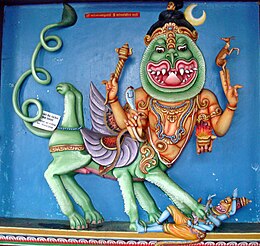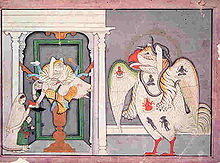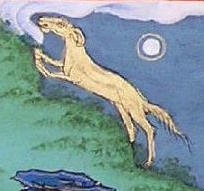Sharabha

Sharabha (
The
In
Development and iconography
In early
Shiva's incarnation
In

The iconography of Sharabheshvaramurti (Shiva as Sharabha) is specifically defined in texts such as Kamikagama and Sritattvanidhi. In Kamikagama, Sharabha is described in the form of a bird with golden color, with two uplifted wings, two red eyes, four legs in the form of a lion touching the ground, four legs with claws upwards, and with an animal tail. The top part of the body is shown as human but with the face of a lion with an ornamented crown; side tusks are also depicted giving an overall frightening sight. It also shows the Narasimha beneath Sharabha's legs as a lion-faced human with anjali (hands folded prayer gesture).[13] (See Infobox image)
In the Sritattvanidhi, the depiction prescribed for Sharabheshvaramurti is of thirty arms; arms on the right are to hold
The
A sculpture of Sharbeshwaramurti in the Tribhuvanam temple, a Shiva temple in
In iconographic representations of the myth of Shiva vis-à-vis Vishnu, Sharabha form has been built around Narasimha but substantially embellished with wings to represent Kali and Durga to denote the female powers (shaktis) of Shiva; Sharabha is also shown with a bird head and a serpent in his beak.[18]
In Hindu scriptures
In the Mahabharata
The
Shaiva views

The legend of Sharabha as an incarnation of Shiva is narrated in many Hindu scriptures and each presents a different version to suit one's religious beliefs. But one common refrain in all these depictions is that Sharabha is a combination of a huge animal-bird beast with enormous strength manifested with the purpose of pacifying similar ferocious avatar of Vishnu such as Narasimha (man-lion).
The Narasimha-Sharabha legend is linked to deities assuming mythical animal forms to slay or subdue each other. Vishnu assumed the form of Narasimha to slay Hiranyakashipu, an asura (demon) king, who was terrorising the universe, and was a devotee of Shiva.[1][8]
The
The
In the Kalika Purana, Varaha - Vishnu's boar avatar - had amorous dalliance with the earth goddess. He and his three boar sons then created mayhem in the world, which necessitated Shiva to take the form of Sharabha, to kill the Varaha form. Here, Narasimha appears to aid Varaha. Sharabha kills Narasimha first and then kills Varaha, allowing Vishnu to reabsorb the energies of both his forms.[9][12][24] Finally, Sharabha defeats Vishnu.[9][12][24] This version of the story finds an allusion in the Prapanchasara Tantra.[25]

Vaishnavas including
Shaivasarvasvakhandanam.[26]
The Vathistabhana Purana, the Vimathgira Purana, the Pradhana Purana, the Prahladhasvayam Purana, the Bhalukka Purana, and some other regional South-Indian scriptures narrate that Narasimha took the form of
There is also a reference to Sharabha in the
Narasimhan Krishnamachari, a scholar on the
In Buddhist scriptures

In the Jataka tales of the Buddha's previous lives, there is narration related to his birth as Bodhisattva in a forest as a Sharabha, the eight-legged deer. A king, while trying to hunt the deer, fell into a precipice with his horse. The deer, instead of abandoning the king to his fate, rescued him. The king was deeply touched by the compassionate gesture and banned hunting in his country.[31][32]
In Tibetan Buddhism, sharabha is represented as a beast with a goat's head and horns, a lion's mane and horse's body and legs. It symbolizes determination, strength and speed. Sometimes, it is represented additionally with horns of an antelope and claws of an eagle. Sometimes, the goat head is replaced by a lion's, horse's feet by a lion's and horns can be of a ram. A common feature of all representations is the horse's body. It is often depicted as mounts of young Devas or dwarfs in a Torana – a six-level archway behind an enlightenment throne of a Buddha or Bodhisattva. Together with the devas, they symbolize the perfection of effort (virya).[33][34]
As emblem

The Government of Karnataka, the University of Mysore and the Karnataka Soaps and Detergents Limited have adopted Sharabha, with modifications in their emblem.[35][36]
In Karnataka Soaps and Detergents Limited logo, Sharabha is depicted in the form of a body of a lion with the head of an elephant to represent the virtues of wisdom, courage and strength.[37]
See also
References
- ^ )
- ^ "शरभ". Monier Williams Sanskrit-English Dictionary. p. 1057. Archived from the original on 26 February 2012. Retrieved 18 January 2010.
- )
- ISBN 978-81-206-0140-6.
- ISBN 978-1-4437-7716-2. Retrieved 15 January 2010.
- ISBN 978-81-208-1396-0. Retrieved 15 January 2010.
- ISBN 978-81-208-1618-3. Retrieved 15 January 2010.
- ^ )
- ^ ISBN 978-81-269-0169-2. Retrieved 15 January 2010.
- ^ ISBN 978-0-88706-981-9.
- ^ ISBN 978-81-208-0878-2. Retrieved 15 January 2010.
- ^ ISBN 978-81-208-1124-9. Retrieved 15 January 2010.
- ^ Rao pp.172–173
- ^ Rao p.173
- ISBN 978-0-521-52865-8. Retrieved 15 January 2010.
- ^ Rao p.174
- ^ a b "Gandaberunda- The Two Headed Bird". Kamat Potpourri. Archived from the original on 2 February 2014. Retrieved 10 January 2010.
- ISBN 978-0-691-01930-7. Retrieved 15 January 2010.
- ISBN 978-0-559-13713-6. Retrieved 15 January 2010.
- ^ )
- ISBN 978-0-7914-0799-8.
- ^ ISBN 8120820495. Retrieved 15 January 2010.
- ISBN 978-0-19-520250-2. Retrieved 15 January 2010.
- ^ ISBN 9780231137485.
- ^ "Prapanchasara Tantra of shankaracharya vol 1-Arthur Avalon".
- ISBN 978-81-208-1575-9. Retrieved 15 January 2010.
- ISBN 978-81-206-0140-6.
- ] Stanza 37, line 1: "atulah sharabhah bheemah samayagno havirharih sarvalakshanalakshanyah lakshmeevaan samitinjayah."
- ^ Tapasyananda, Swami, Sri Vishnu Sahasranama, pg. 91, Chennai: Sri Ramakrishna Math. Sanskrit and English, with an English translation of Sri Sankara Bhagavatpada's commentary.
- ^ a b c "Vishnusahsranamam, Volume II- Annotated Commentaries by Sri Narasimhan Krishnamachari" (PDF). hobilavalli.org. Retrieved 21 January 2010.
- ^ "Shakyamuni Buddha - Jataka (previous lives)". Archived from the original on 31 October 2013. Retrieved 9 January 2010.
- ISBN 978-81-206-1469-7.
- ISBN 978-1-932476-10-1.
- ISBN 978-1-932476-03-3.
- ^ "Gandaberunda- The Two Headed Bird". Archived from the original on 2 February 2014. Retrieved 12 April 2007.
- ^ "The University Emblem". University of Mysore. Archived from the original on 27 October 2013. Retrieved 10 January 2010.
- ^ "Profile: Sharabha". Karnataka Saops and Detergents Limited. Archived from the original on 10 June 2010. Retrieved 9 January 2010.


